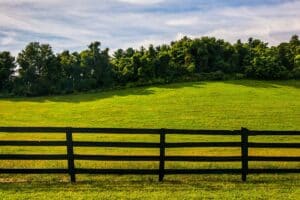I am a nonpoint-source (NPS) polluter.
Everyone I know — and everyone I see around here, everyone — is just like me.
None of us permanently fence livestock out of our farm watercourses that form the Virginia headwaters of the Potomac and James Rivers.
Our cattle, sheep, horses, llamas as well as organic free-range poultry deposit nutrients — principally water-soluble nitrates and phosphates — in their waste products daily, sometimes hourly. Cropland and pasture can absorb some of this material without affecting water quality.
What isn’t incorporated and what’s deposited directly into running water, however, travel downstream into the Chesapeake Bay. Each pasture or manure-fertilized farm in its 64,000-square-mile watershed contributes to the buildup. An overload of nutrients causes high rates of algae and other plant growth, which limits the light-absorption capacity of the water on which the grassbeds depend and depletes oxygen, which makes life hard for those that depend on it. Despite several decades of goal-setting and concern, the Bay is not infrequently described by its friends as an environmental zombie. Other watersheds around the country also struggle with nutrient overloading.
My farm and others pollute these waters in other ways too. Manure carries bacteria and other vectors of disease. A second type is water-soluble inorganic pollutants, such as toxic metals, salts and acids. A third type is organic compounds, such as petroleum products and pesticides. And a fourth is suspended sediment—particulate matter that reduces the water’s ability to absorb light and affects the health of fish populations.
Clean-water legislation focused on controlling point sources of pollution from the likes of sewage plants and industrial sites, which, in the early 70s, were thought to contribute about 85 percent of the water-pollution problem. Today, point sources are highly regulated and contribute only about 15 percent of the pollution; NPS pollution, such as the runoff from farms (including mine), precipitation, drainage and all other sources that don’t qualify as point sources, now contributes an estimated 85 percent. In addition to livestock in water, fertilizer applications — particularly from poultry litter, large dairy operations and municipal sludge — contribute to nutrient overload. Most individual nonpoint sources contribute a little bit of pollution, but the cumulative load is very large.
Fencing livestock out of watercourses would reduce nutrient loading and contribute to helping the Bay, but it’s only one among a number of nonpoint-sources of pollution that make up the problem.
As always, hard questions arise over what seems to be a fairly straight-forward matter.
First, are the additional cost and limitations that nitrogen reduction through additional livestock fencing worth the gain? Some would argue that cost should not be a consideration at all. Others argue that the marginal improvement in water quality that would result from fencing would have only marginal impact on the Bay’s environmental and aesthetic qualities.
Second, there is the question of who should pay for installing the huge amount of fencing that would be required, as well as its routine maintenance and subsequent replacement? Should polluters — that is, individual farmers — pay for their own fencing? Should there be a livestock tax or a meat-consumption tax to finance the program? Should the expense be cost-shared or tax advantaged (beyond being deductible)? Should small farm polluters be exempt from a fencing requirement?
Third, should the fencing be permanent or would temporary fencing be permitted? I do rotational grazing, such that cattle are next to a stream perhaps 30 days out of a 180-day grazing season. Would I be allowed to rig up a temporary electric fence during those grazing days?
Fourth, who would enforce compliance and what would be the penalties? How could thousands of farms be inspected? Through satellites? Is that where we want to go?
Fifth, how would a baseline measurement of individual farm loading be established and then monitored?
Nothing is simple, easy or cheap about this idea. But as the focus shifts from point-sources tononpoint sources, fencing will be increasingly on the agenda—and that will affect most farmers, consumers and taxpayers.
Footnote: Robert McCartney added another perspective on this issue with his column, “Redefining the beautiful lawn when it comes to bay’s health,” Washington Post, April 25, 2010. He reports on an April, 2010 study by Chesapeake Stormwater Network that found that “mowed turf grasses” (i.e., lawns) have become the largest “crop” in the Chesapeake Bay’s watershed. And this crop involves fertilizers, herbicides and pesticides–all of which, in part, find their way into the watershed’s streams and rivers as runoff. Lawns are not the biggest sources of such pollution, but they are the only source that is rising; agriculture, sewage and air contamination are falling. The largest area of mowed turf grasses is the D.C. metropolitan region north to Lancaster, Pa. The White House lawn is part of the problem.
This content may not be used or reproduced in any manner whatsoever, in part or in whole, without written permission of LANDTHINK. Use of this content without permission is a violation of federal copyright law. The articles, posts, comments, opinions and information provided by LANDTHINK are for informational and research purposes only and DOES NOT substitute or coincide with the advice of an attorney, accountant, real estate broker or any other licensed real estate professional. LANDTHINK strongly advises visitors and readers to seek their own professional guidance and advice related to buying, investing in or selling real estate.








Curtis, good article. I do some sampling and reporting on an NPDES permit (EPA) and an SID permit (ADEM) for a facility adjacent to the only threatened stream in our county. I hope legislators take a common-sense approach to addressing these concerns. Allowing native grasses to grow and promoting stream-side management zones is an easy and fairly inexpensive way to buffer some of the run-off and draining of open pastures. This issue will likely become more important to farmers and landowners as environmental agencies tighten regulations. Now if we can only clean up the major oil spills in the gulf we’ll be in good shape.
The point I meant to make is how difficult it is to show that you are in compliance with regulations. Should non-point source entities be forced to comply with new laws, documenting and managing the requirements becomes tedious and a burden to landowners.